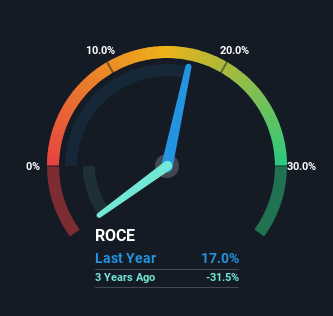
To find a multi-bagger stock, what are the underlying trends we should look for in a business? Typically, we'll want to notice a trend of growing return on capital employed (ROCE) and alongside that, an expanding base of capital employed. This shows us that it's a compounding machine, able to continually reinvest its earnings back into the business and generate higher returns. So on that note, Hanatour Japan (TSE:6561) looks quite promising in regards to its trends of return on capital.
Return On Capital Employed (ROCE): What Is It?
Just to clarify if you're unsure, ROCE is a metric for evaluating how much pre-tax income (in percentage terms) a company earns on the capital invested in its business. Analysts use this formula to calculate it for Hanatour Japan:
Return on Capital Employed = Earnings Before Interest and Tax (EBIT) ÷ (Total Assets - Current Liabilities)
0.17 = JP¥1.2b ÷ (JP¥9.7b - JP¥2.7b) (Based on the trailing twelve months to March 2024).
Therefore, Hanatour Japan has an ROCE of 17%. In absolute terms, that's a satisfactory return, but compared to the Hospitality industry average of 9.8% it's much better.
View our latest analysis for Hanatour Japan

While the past is not representative of the future, it can be helpful to know how a company has performed historically, which is why we have this chart above. If you want to delve into the historical earnings , check out these free graphs detailing revenue and cash flow performance of Hanatour Japan.
What Does the ROCE Trend For Hanatour Japan Tell Us?
Hanatour Japan has not disappointed in regards to ROCE growth. The figures show that over the last five years, returns on capital have grown by 133%. That's not bad because this tells for every dollar invested (capital employed), the company is increasing the amount earned from that dollar. Interestingly, the business may be becoming more efficient because it's applying 33% less capital than it was five years ago. Hanatour Japan may be selling some assets so it's worth investigating if the business has plans for future investments to increase returns further still.
On a related note, the company's ratio of current liabilities to total assets has decreased to 28%, which basically reduces it's funding from the likes of short-term creditors or suppliers. So shareholders would be pleased that the growth in returns has mostly come from underlying business performance.
What We Can Learn From Hanatour Japan's ROCE
From what we've seen above, Hanatour Japan has managed to increase it's returns on capital all the while reducing it's capital base. And with a respectable 72% awarded to those who held the stock over the last five years, you could argue that these developments are starting to get the attention they deserve. Therefore, we think it would be worth your time to check if these trends are going to continue.
If you'd like to know about the risks facing Hanatour Japan, we've discovered 1 warning sign that you should be aware of.
While Hanatour Japan may not currently earn the highest returns, we've compiled a list of companies that currently earn more than 25% return on equity. Check out this free list here.
Valuation is complex, but we're here to simplify it.
Discover if Hanatour Japan might be undervalued or overvalued with our detailed analysis, featuring fair value estimates, potential risks, dividends, insider trades, and its financial condition.
Access Free AnalysisHave feedback on this article? Concerned about the content? Get in touch with us directly. Alternatively, email editorial-team (at) simplywallst.com.
This article by Simply Wall St is general in nature. We provide commentary based on historical data and analyst forecasts only using an unbiased methodology and our articles are not intended to be financial advice. It does not constitute a recommendation to buy or sell any stock, and does not take account of your objectives, or your financial situation. We aim to bring you long-term focused analysis driven by fundamental data. Note that our analysis may not factor in the latest price-sensitive company announcements or qualitative material. Simply Wall St has no position in any stocks mentioned.
About TSE:6561
Hanatour Japan
Operates as a travel portal company in Japan and internationally.
Flawless balance sheet with solid track record.


